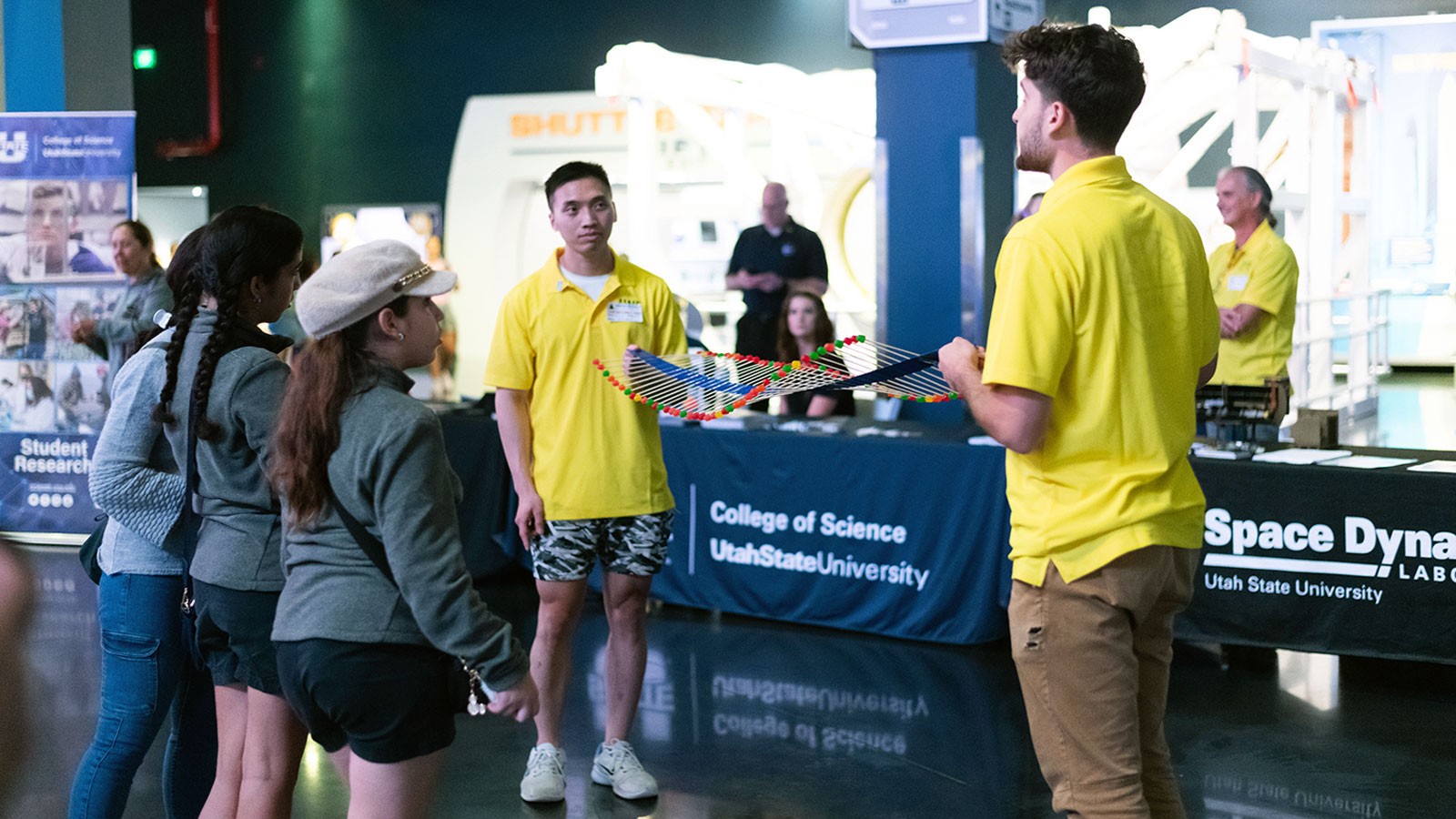Sharing Wonder: USU Physics Students Practice STEM Outreach at NASA's Kennedy Space Center
Atmospheric Waves Experiment Science Team hones communications skills while participating in research-project-of-a-lifetime.
By Mary-Ann Muffoletto |
Video by Taylor Emerson, Digital Journalist, University Marketing & Communications
During weekly meetings around a crowded physics department conference table, members of Utah State University’s NASA-funded Atmospheric Waves Experiment (AWE) Science Team toss around terms and phrases like “burstiness,” “contested spikes,” and “gravity wave-breaking events to demonstrate temporal variability.” To the uninitiated, the conversation is nearly unintelligible.
“At times, I’m not even sure what we’re talking about,” says Joe Pigott, an undergraduate team member, but explaining the research to others, he says, has given him a firmer grasp on what the space mission is all about.
Pigott is among students who on Nov. 9, 2023, accompanied the team’s USU Physics faculty members to the Cape Canaveral launch of the AWE instrument, built by USU’s Space Dynamics Laboratory, to the International Space Station.
With fellow team members, Pigott spent two days prior to the trip in intensive communications training with SDL Public Relations Director Eric Warren, in preparation for three pre-launch days at Florida’s Kennedy Space Center explaining the mission to visitors of all ages.
“Talking with dozens of people about a subject really improves your understanding of it,” he says. “And teaching people about something you’re passionate about is so fun. There’s something so fulfilling about spreading the love of science to broader audiences.”
Anh Phan, a doctoral student on the AWE Team, says engaging with visitors at the Kennedy Space Center was both challenging and rewarding.
“We encountered a variety of questions, some new to us, which deepened our understanding of the AWE mission,” Phan says. “The training we received from Eric, in which he taught us to identify and effectively communicate key messages to a diverse audience, was invaluable.”
Student Connor Waite agrees.
“Meeting with the public was certainly very different from working in the lab, and I’m grateful we had some time to practice talking about the research amongst ourselves and in practice video sessions prior to our trip,” he says. “It was fun to answer guests’ questions and to see children and teens light up, when we had them participate in our wave demonstration.”
Denise Hill, NASA’s Heliophysics Communications and Outreach Lead, praised the USU students’ innovative methods of communicating science.
"Watching the USU students explain gravity waves using a very simple, yet effective visual aid made of gum drops, sticks, and string was incredible,” Hill says. “I had a general understanding of gravity waves, but having the students explain the concept coupled with the demonstration created an ‘aha’ moment for me."
Pigott says those moments, when he observes someone suddenly grasping a new concept, make outreach a favorite experience.
“As a teaching assistant at Utah State, I’ve always enjoyed instructing peers,” he says. “But the trip to the Kennedy Space Center may have solidified my decision to make teaching my career. Seeing the kids at our exhibit struggle with new concepts, then finally connect the dots was one of the best feelings in the world. I would love to pursue a career, where I get to experience that again and again.”
Phan says watching his fellow students, as well as USU faculty members, as they spoke with the public and gave live demonstrations and presentations was especially enlightening.
“I learned a lot from speaking to guests and speaking on camera, but I also learned from watching everyone else,” he says. “This experience highlighted the importance of teamwork.”
Waite, who was selected to present about the AWE mission with a jumbotron screen before a live audience during the launch countdown, collaborated with faculty and mission scientists as he prepared his delivery.
“While I gave the presentation on my own, it was truly a team effort to prepare for it,” he says. “In fact, all of the outreach I participated in, from filming videos for social media to teaching tourists about our research, was a team effort involving a lot of helpers and weeks of preparation.”
And on the night of the launch, Waite hit it out of the park.
“I could feel the excitement in the air, as I scanned the audience and realized so many in attendance had spent years working on the AWE mission,” he says. “While I spoke, I acknowledged everyone’s contributions and tried to give them opportunities to express the excitement I knew they were feeling, while also letting my own excitement show. When I finished talking about atmospheric waves, I had the crowd do a ‘wave’ across the bleachers. It may have seemed a little on the nose, but everyone had a great time with it.”
AWE is a Mission of Opportunity under NASA’s Heliophysics Explorers Program, which conducts innovative, streamlined scientific investigations by developing instrumentation to answer focused science questions that augment and complement the agency’s larger missions. AWE joins a fleet of heliophysics missions positioned at key places around our solar system, which together seek to understand the nature of our Sun and how it influences Earth, the nature of space, our solar system, and our universe – and, in turn the people and technology here.
This material is based upon work supported by the National Aeronautics and Space Administration under Contract Number 80GSFC18C0007. Any opinions, findings, and conclusions or recommendations expressed in this material are those of the author(s) and do not necessarily reflect the views of NASA.
USU Physics scholars Anh Phan, center, and Joe Pigott, right, use a model made from wooden skewers and gumdrops to demonstrate atmospheric gravity waves to young guests at NASA's Kennedy Space Center in Florida. (Photo Credit: SDL/Allison Bills)
WRITER
Mary-Ann Muffoletto
Public Relations Specialist
College of Science
435-797-3517
maryann.muffoletto@usu.edu
CONTACT
Ludger Scherliess
AWE Mission Principal Investigator
Department of Physics
435-797-7189
ludger.scherliess@usu.edu
TOPICS
Hands-on Learning 220stories STEM 184stories Space 142stories SDL 89storiesComments and questions regarding this article may be directed to the contact person listed on this page.







